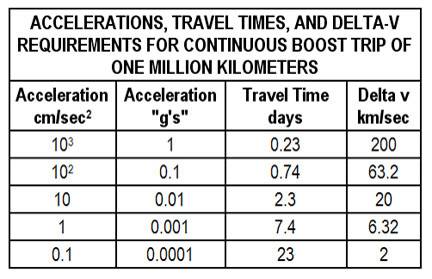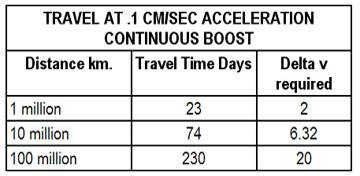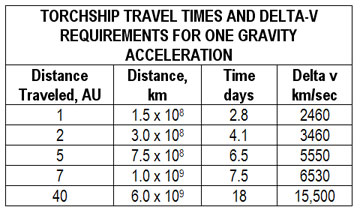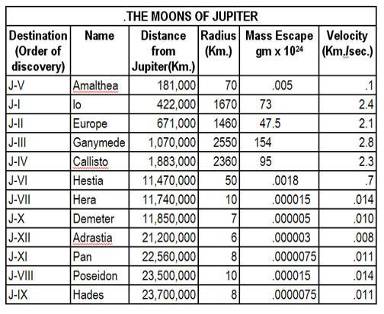A Step Farther Out (25 page)

Transit times
below
the diagonal; synodic periods above the diagonal. All figures given in Earth years.__________
Out that far from the Sun's influence, and only going a million kilometers anyway, we don't have to use Hohmann orbits. One of the Belters' usual (science fiction) devices is the torchship, which accelerates halfway to where you're going, turns over, and decelerates back again. Orbital flight doesn't really work that way, but this will do as an approximation. figures 16 and 17 show what it takes to do that.
Examining Figure 16 we see the Belters have a problem. Any group of two or three aren't so far apart that they couldn't go see their neighbors, using the 1 cm/sec acceleration and taking a day off to do it; but at 6 km/sec delta v you won't do it often. You could try a lower acceleration, and get to more places, but before you go far, time and energy stop you again. A cluster of rocks might proclaim independence, but that cluster will be a long way from any other cluster. We could conceivably have a number of Belter Civilizations, but hardly a single Belt-wide government, even with 20km/sec delta-v torchships.
Those "torchships" present a problem anyway. Continuous boost may be easy on the passengers, but it uses up delta v like mad. The one gravity boost trip for a lousy million kilometers takes more delta v than 10 round trips to Ceres! It gets worse when you try to boost over long distances, too. Figure 18 shows some representative requirements for torchship travel between planets. Sure, the travel times are now very short, and the Belt Civilization is in business: you can get from one side of the belt to the other, 7 AU, in a week, so trips to the Capital, no matter where it is, are no problem.
__________

Figure 17
Note: figures for very low accelerations will necessarily be inaccurate.__________

Note: the model is especially inaccurate for very long trips.
__________
However, trips
anywhere
are no problem if you have torchships. Why bother avoiding the 8 or 9 km/sec penalty for landing on Mars or going to Earth? The "holes" aren't very deep when you have a ship like that; certainly you can afford to go to Earth orbit, and Earth is still likely to be closer to you than the Belt Capital.
Furthermore, it's hard to see how the torchships will work. The usual explanation in science fiction is "atomic power," but that's not really the whole story. We already have, or very nearly had, an "atomic powered" rocket, NERVA, but it wouldn't do anything like
that.
NERVA is an atomic pile through which hydrogen is poured as a coolant The pile heats the hydrogen which therefore goes aft, fast, and the rocket moves.
We could have built a NERVA engine weighing about 35,000 pounds and delivering some 250,000 pounds of thrust by the end of this decade; the development was moving very well when Congress decided to cancel the program. Incidentally, more money is annually spent on lipsticks in New York state than NERVA was costing, and any medium-sized state has more annual sales of liquor than NERVA cost over its lifetime; but it's nice that they don't waste the taxpayers' money with frivolities like space. Editorials aside, it's reasonable to assume NERVA-type ships will first explore the asteroids.
The design spec for NERVA was an I
sp
of 800 seconds. I
sp
is pounds thrust per second per pound of fuel used, and is thus the measure of fuel efficiency. The 800 second ship might have flown by 1980, and a second NERVA with I
sp
of 1300 seconds was possible by 1990. Given the I
sp
we can calculate temperatures of the exhaust gasses, and thus see what we have to handle to get really efficient rockets.
Figure 19 shows some of these—and shows we're in trouble again. NERVA used a system in which the fuel passed through pipes in the motor wall to cool that before it went into the reactor chamber, and with similar design features could handle gasses with temperatures in the 975-1300 I
sp
region, but the 2950 is very much an upper limit; no pile system will withstand temperatures of 50,000° Kelvin.
It follows that the best NERVA we could build won't be a torchship. With 50% of the total weight in fuel, and nearly 3000 seconds I
sp
, we have a ship capable of cruising between the asteroids and Earth; in fact, it can go almost anywhere in the solar system, but only in Hohmann transfer orbits. It can't accelerate continuously.
Actually, even if we could get 1,000,000 °K temperatures we only have 208 km/second delta v with a ship that's 80% fuel. This is very respectable (although I don't know how we control that temperature) but it's only good for one, count 'em, one continuous burn for a million kilometers at one g. A million kilometers is not far in the solar system. True, this theoretical ship might make one of the lower acceleration boosts, but it's still no torchship as usually given to the Belters by SF writers.
Well, if NERVA can't do it, what about a "true" nuclear rocket: one that uses controlled fusion? Thermonuclear reactions surely will give enough energy for torching, won't they?
Not by themselves. There's plenty of energy in fusion, but how do you
contain
it? On Earth, with huge tokomak rings generating enormous magnetic fields, we might be able to build a magnetic pinch-bottle to hold a controlled fusion reaction; but aboard a
space ship?
If you can build something light enough to go aboard a ship smaller than the
Queen Mary
and able to contain controlled fusion, you've got a device that will change far more than the asteroid Belters: it's obviously a defense against hydrogen bombs, to begin with. We'll discuss various properties of fusion powered ships some other time; for now, it's enough to point out that they aren't the panacea we wish they were.
__________

__________

(K. E. = T x Boltzmann Constant, which I won't explain = ½ m v
2
; table assumes monotomic hydrogen fuel, with mass of 1.6733 X 10
-24
grams/particle.)__________
Well, what
can
the Belters do? They can get around with NERVA engines, but what do they use for fuel? There isn't a lot of hydrogen out among the asteroids.
Oddly enough, there is a propulsion system that gets I
sp
(theoretical) in the region of 20,000 seconds, doesn't have excessive real temperatures, and can be built right now Even better, it's likely we can find fuels for it in the Belt.
This is the ion drive ship. Ion drives employ metal vapors as fuel, and the metal is accelerated by magnetic fields, not heat. If the asteroids turn out to be rich in metals, some kind of ion rocket may be just what the Belters need. It lets them get fuel from the rocks. But even with a 30,000 second I
sp
ion drive we won't have a torchship for driving around at one g. Torching uses too much energy, and the ion drive won't develop the needed thrust anyway. A mercury vapor ion engine, for example, although very efficient, only gives thrusts of about 10
-4
g. You get there efficiently, but it takes a long time.
No, the conclusion is obvious: with anything foreseeable in the way of rockets, the Belters aren't going to develop their civilization. They won't have ships good enough to let them reach each other—and if they do get such ships, it's as easy to reach Earth as the other asteroids. With real torchships, both the Belters and the Earth Navy will have no trouble getting anywhere. I'm afraid the Belter Independence Movement is a long way off.
What with science robbing SF writers of Mars, and Venus, and now the Belters, it's all rather sad, and I've been looking for something more cheerful. I may have found it.
The Jovian Moons offer a distinct possibility for a multi-world civilization. They're respectable in size, and may well have water ices, or methane, or some other source of hydrogen on them: fuel for a NERVA engine without sending out to Mars for it.
It takes a long time to get to Jupiter's moons, so there's an incentive to stay there once you've arrived; yet it takes less delta v to get to a Jovian moon than to land on Ceres. May be we should go there first?
__________

Data from C. W. Alien,
Astrophysical Quantities,
2nd ed. 1963, University of London, Athion Press. Assumes density of 3.5 grams/cm
3
when no value is known.
This is the usual mass for asteroids. J-XII, XI, VIII, and IX are retrograde and highly inclined, and no calculations of velocity changes required for trips to or from them were made; their characteristics are included here only for completeness and because the data were already calculated.___________
The basic characteristics of the Jovian system are given in Figure 20. We've had to assume a lot of things to get these numbers, and by the time this appears some of the figures may be out of date: Pioneer will encounter Jupiter during the interval between now and when this is published. I'll be the first to cheer if Pioneer makes hash of my assumptions.